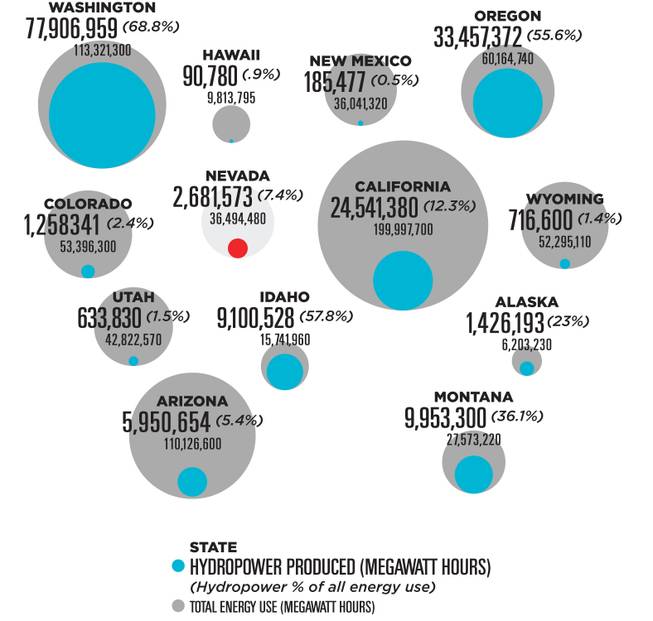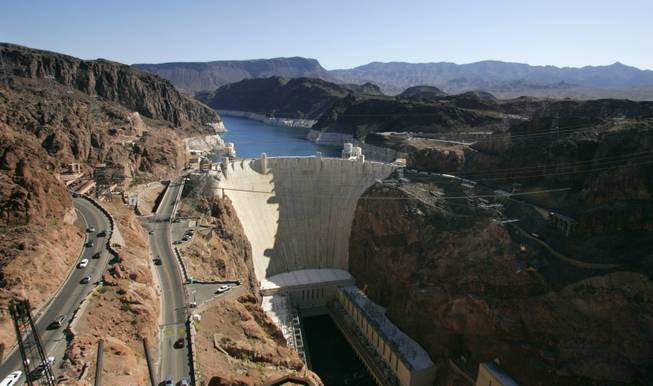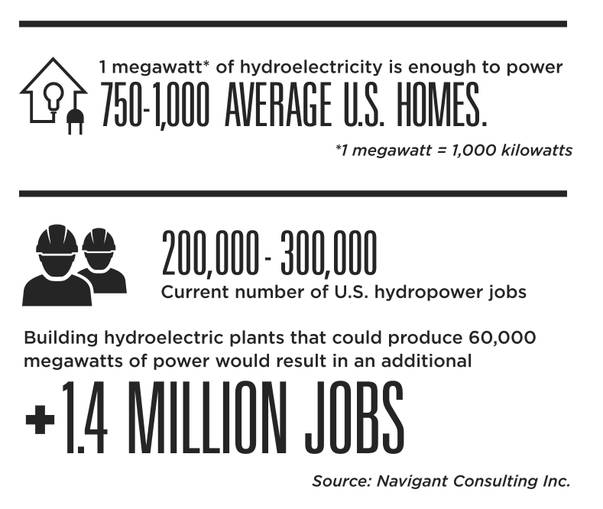Monday, June 1, 2015 | 2 a.m.
Hydropower, derived from falling or running water, is the oldest renewable energy technology in existence and the United States’ largest source of renewable electricity. Last year, hydropower accounted for about 6 percent of total U.S. electricity generation and 52 percent of generation from all renewables. But it could produce even more. Only 3 percent of the 80,000 dams in the United States make electricity. Most were constructed for irrigation and flood control.
There are several types of hydropower. The most common is conventional hydropower, typically associated with dams, which store water behind a generating facility and harnesses its power through a turbine. However, new technologies are emerging to produce energy from ocean waves, tides and naturally-flowing water.
How it works
Hydropower uses the water cycle — evaporation, condensation, precipitation and collection — to produce electricity, typically through a dam.
1. Water in a reservoir is drawn into the dam through a penstock, a chute that forces the water down to a turbine.
2. When the water hits the turbine’s blades, it forces them to spin, turning a shaft connected to a generator.
3. The generator produces electricity that travels to a transformer, which converts it to a higher voltage suitable for the transmission grid.
4. The power is sent to the grid to be used in homes, businesses and government offices.
The amount of energy available in moving water is determined by flow and fall. Swiftly flowing water carries a large amount of energy, as does water descending rapidly from a high point.
Around the United States
Hydropower supplies nearly one-fifth of the world’s energy each year. Domestically, the federal government owns 52 percent of hydropower plants, while 48 percent are owned by private and public utilities (including the Southern Nevada Water Authority), cities and others.

Pros
■ Because hydropower is fueled by water, it doesn’t pollute the air like fossil fuel plants do.
■ Hydropower relies on the natural water cycle, so it is a renewable power source.
■ Reservoirs created for hydropower often serve as recreational hubs for fishing, swimming and boating.
■ Hydropower facilities can go from zero to maximum output quickly and provide essential backup power during major electrical outages.
■ Hydropower infrastructure helps with flood control, irrigation and water supply.
■ Hydropower projects tend to have a longer lifespan than other power generating facilities, meaning infrastructure costs are spread across a longer timeframe. Plants also typically operate for long periods of time without needing major replacements or repairs.
Cons
■ Droughts could affect hydropower generation.
■ Damming water and changing flow patterns can negatively affect the environment and wildlife.
■ Hydropower plant operations may increase silting, change water temperatures and lower levels of dissolved oxygen in the water.
■ Initial construction of a hydropower plant can be expensive (between $50 million and $250 million), although long-term maintenance is more reasonable.
In Nevada
NV Energy’s HydroGenerations program encourages agriculture and tribal customers to install micro-hydro systems on their land by offering financial incentives. The program, created by the state Legislature, will remain open to applicants until Dec. 31, 2020, or until the $2.6 million program budget has been allocated.
Hydropower, primarily from the Hoover Dam, accounts for about 40 percent of the renewable energy produced in Nevada.
The Hoover Dam
The Hoover Dam harnesses the energy of the Colorado River to produce about 4 billion kilowatt hours of hydroelectric power annually for Nevada, Arizona and California, enough to serve 1.3 million people. From 1939 to 1949, it was the world’s largest hydropower plant. Today, it remains one of the country’s largest. During the Great Depression, thousands of families relocated to Nevada and northern Arizona to help construct the dam. Standing 726 feet tall and 1,244 feet wide, it was completed in fall 1935.
Money made from selling power generated at Hoover Dam is used to pay for the site’s operation, maintenance and repairs. The cost of building the dam was recouped by May 1987.
How energy generated at Hoover Dam is allocated
■ 28.54% Metropolitan Water Dist. of Southern Calif.
■ 23.37% Nevada
■ 18.95% Arizona
■ 15.4% Los Angeles, Calif.
■ 5.5% Southern California Edison Co.
■ 1.8% Boulder City
■ 1.6% Glendale, Calif.
■ 1.1% Anaheim, Calif.
■ 1.4% Pasadena, Calif.
■ 0.9% Riverside, Calif.
■ 0.6% Burbank, Calif.
■ 0.1% Azusa, Calif.
■ 0.09% Colton, Calif.
■ 0.6% Vernon, Calif.
■ 0.04% Banning, Calif.
Sources: U.S. Office of Energy Efficiency and Renewable Energy, National Hydropower Association, Electric Power Association




Join the Discussion:
Check this out for a full explanation of our conversion to the LiveFyre commenting system and instructions on how to sign up for an account.
Full comments policy